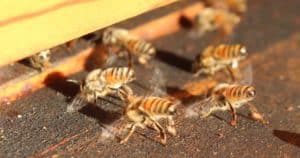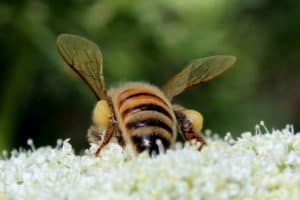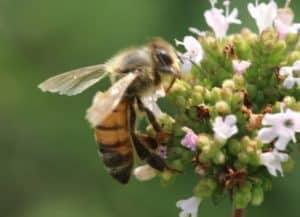I spend a lot of time taking photographs of bees, particularly as they flit from flower to flower gathering pollen or nectar. All of this time spent stalking them through gardens has given me appreciation and wonder of their flight capabilities. Bees are capable of flying at speeds up to 15 mph and carrying nectar loads that approach their own body weight. In addition to these feats of strength, they are also capable of delicate maneuvering and hovering while they approach flowers. These amazing aerial abilities are of course made possible by their wings, which at a glance seem undersized for the task.
At this point, a confession seems reasonable: I was several years into working with bees on a daily basis before I learned that they actually have four wings, not two. In fairness to myself, I hadn’t had even the most basic course in entomology and only barely knew that bees weren’t technically bugs. Honey bees, like other winged Hymenopterans, have four wings, while insects of the order Diptera, including true flies and mosquitoes, have a single pair (remember, di = 2). For what it’s worth, only insects of the order Hemiptera can correctly be called true bugs.

Bees possess a pair of forewings that are similar in length to the abdomen and a smaller pair of hindwings. The 2 vs. 4 ignorance is somewhat understandable when considering that when bees are not in flight the larger forewings cover the hindwings in the relaxed position along the abdomen, and the wings function as a single pair during flight activity. This coupled movement is facilitated by a series of hooks, known as hamuli, on the leading edge of the hindwings that fit into grooves on trailing edge of the forewings allowing the forewings and hindwings on each side of the body to function as a single surface. The wings are powered by the longitudinal and vertical flight muscles in the thorax. Alternating contractions of the vertical and longitudinal muscles raise and lower the wings.

In addition to propelling themselves through the air, the wings are also used to move air while remaining stationary. The ability to move air throughout the colony is critical to maintaining appropriate internal temperature and humidity as well as evaporating moisture from nectar and distributing pheromones within the colony.

The wings themselves are composed of three layers: a transparent membrane on top and bottom supported by a network of veins that carry hemolymph (bee “blood”), nerves, and breathing tubes throughout the wings as well as provide structural support. Honey bee wings exhibit a relatively simple pattern of venation compared to other more primitive insects. Venation patterns can be used to distinguish between subspecies (or races) of honey bees. This requires precise measurements of different sections of the wing and is being increasingly done through automated image processing algorithms.

Despite their durability, honey bee wings are only capable of a finite number of flight miles, with estimates of this upper bound being approximately 500 miles. Close observation of older bees in the colony will often reveal wings that are tattered around edges. As adult bees progress through their lifespan, they take on different tasks and roles in a process known as temporal polyethism with foraging typically being the last activity. When you see an older bee, which can be identified by diminished body hair in addition to tattered wing margins, you’re observing a bee that is near the end of its life. Individual bees only occupy the role of forager for 2-3 weeks, covering hundreds of collective miles in that time. When you see an old bee with tattered wings it is documentation that she has exhausted her physical capabilities in service to the colony and will soon be replaced by a younger bee that transitions from a house bee to a forager.